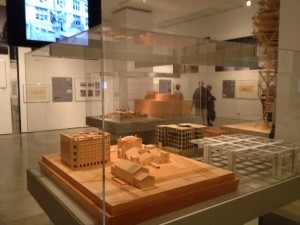Louis Kahn: the Power of Architecture – The Design Museum, London

What the Vitra Museum (it is a travelling exhibition) have done well is to show the constants in Kahn’s work as well as the development of certain ideas. The interest in movement, flow and scalability in cities and large-scale building projects does not feel too forced when applied to the private homes he built, and the integration of his projects into existing urban and natural landscapes continues through to the parliamentary buildings in Dhaka, Bangladesh, with which the exhibition culminates. There was enough background on things like his traffic studies and concept of ‘servant’ and ‘served’ spaces to inform my experience of his projects as viewed through photographs, films and interviews, and the text panels with 2D models of completed buildings were very clear.
When this exhibition is less good is when it is trying to be flashy. The Vitra had commissioned several of the larger models used, which didn’t contribute much to my understanding of their themes and messages, particularly the full-scale (but don’t sit on it) model of a window seat. The sometimes odd quotes on the walls didn’t aid my experience much either apart from being able to have a conversation about whether or not a crocodile does actually want to be a crocodile, and what that has to do with anything anyway. There were a lot of interesting materials which came from closer to the source, including drawings, models, annotated calendars, and even a battered suitcase, which spoke to Kahn’s methods and priorities, and could sometimes have been placed more at the forefront. I also really enjoyed a primer entitled “You and Your Neighborhood”, which had been uploaded to an iPad, and although not solely authored by Kahn, broke down a lot of his ideas about how spaces should work and interact.
I also found a small element of critical reflection to be missing towards the end of the exhibition. Where earlier the texts acknowledge the specificity of the idea of neighbourhood to an Anglo-Saxon tradition, there is a seemingly unselfconscious juxtaposition of local chaos and architecturally imposed order in the display on the Dhaka project. In other words, they presented it as if the Western architect had brought something to the Subcontinent which they would not have been able to create themselves, without much further examination. It’s a small point, but I though it deserved to be delved into more deeply, perhaps. Overall, however, I came away from the Design Museum a lot more knowledgeable about Louis Kahn and his influence on architecture, as well as having a desire to see several of his buildings in person, which is not bad for something I came to with no preconceptions.
